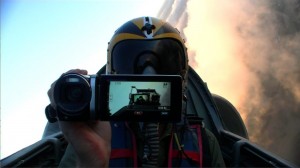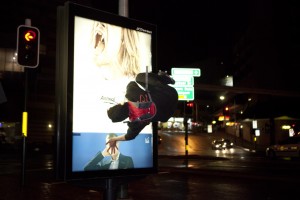Shaun Gladwell: Midnight Traceur and other recent works
 I interviewed Shaun Gladwell at Anna Schwartz Gallery in CarriageWorks on October 25, 2011, during the installation of his exhibition, Riding with Death: Redux. Here’s the text of our interview.
I interviewed Shaun Gladwell at Anna Schwartz Gallery in CarriageWorks on October 25, 2011, during the installation of his exhibition, Riding with Death: Redux. Here’s the text of our interview.
Gladwell, who has moved to London to live, talked about his parkour video titled Midnight Traceur.
This is the one that features this parkour artist, Ali Kadhim. He’s an amazing performer. He’s the star of the show really. He is unbelievable. It starts off in the day, sort of late afternoon, then it moves into these sequences within Sydney at night, so he’s doing these highly athletic performances in various (locations). [The video is slowed to about 40 per cent of real time.] He’s just so incredibly athletic that every single move is just wild. But this is maybe a different experiment to other parkour videos which are usually very fast and furious. But to slow it down, of course I’m interested in the grace, and all of the detail, and also it’s like a structural film so in every scene it flips between a steady cam which is close and chases him, and a wide shot which includes the method in which he was recorded. It flips between the two for the whole video. You always see the performer and this choreography that takes place between the performer and the camera person, and the next scene is the removed view, the wider view.
Shaun spoke about the part of the video where Ali Kadhim interacts with water features.
Yeah, this is when it gets raunchy when he goes and he deals with water. There’s a whole section of the video where he’s sort of dealing with these water features in the city, so it’s really quite a beautiful series of sequences. That’s actually in Darling Harbour. We’re just playing with it in a different way. The work [Midnight Traceur] features as a secret parkour tour of sydney, which I like. So the work really does track this single parkour free-runner — they call them free-runners or traceurs — through his favourite spots in Sydney.
Parkour reminds me of the movements cats make.
It’s interesting you make that reference to cats because Ali is probably the best known parkour free-runner in Australia, and they have crews like break dancers and his is called Nine Lives which I think is appropriate because I think he’s probably already spent eight doing this. But they love the cat aesthetic and one of the moves is called a cat jump.
 It’s like urban ballet.
It’s like urban ballet.
It is, it’s a good way to describe it. There’s an incredible amount of skill involved. And it’s interesting because it in a way redesigns space through performance. I always see it as like these other urban activities I’m interested in, where there’s a function that was intended for that space, where that architect or civil engineer or landscape gardener had a particular purpose in mind and there’s this other purpose that gets attached to it, kind of like a para-function, and this is what I’m interested in, this idea that they’re bringing their own interpretation of use to the space.
Shaun stopped to speak about a particular part in the video.
This is actually not parkour. Ali is involved in break dancing and martial arts as well. And he’s incredibly good at parkour and break dancing and martial arts. So these are actually break dancing moves. And this is actually a capoeira move. So it’s almost like he’s involved in all these different styles. The thing that I love about his practice of parkour is that it’s not just pure parkour, whatever pure parkour is. He’s the multidisciplinary parkour free-runner, and there are not too many around.
That’s a wild move. Basically just playing with the city. But I do love the idea that he educates younger practitioners, and they do have this history that’s borrowed from break dancing which is this idea of battling where they have rival gangs but it’s actually not fighting, it’s just testing each other’s skills. So instead of gang-related violence, they’re actually dancing with each other.
Shaun spoke about the exibition in general, which included other works.
There’s quite a lot of disorientation going on in the show. Like the body is involved in a kind of manipulation of gravity and space. [In the video titled I also live at one infinite loop] the figure is in a military aircraft and what’s taking place is it’s an aerobatic experiment. It’s actually myself in this jet fighter with this acrobatic pilot and the guy’s like a military pilot so he has this aircraft that’s capable of doing these incredible things, so as you can see the horizon starts to kind of warp and the idea of wherever north is or the sky starts to become a little bit confused.
In this work I really love the idea that the military technology is being played with somehow. It’s not being used for its intended application, which is horrific. It’s being used as a kind of play thing, or a toy. And also the cameras are fairly dysfunctional when they’re looking at each other like that. They’re recording a landscape and a figure within a landscape, but the feedback loop is in a way a distortion of the camera’s function. You can’t even control it, and the camera was never designed to go into feedback. It was always designed to just shoot a picture plane in front of it. So there were several little plays going on.
Where did you shoot the video, I also live at one infinite loop?
This one was in Australia. I did get the idea in Afghanistan [where Shaun was sent as an official Australian war artist], working with these sort of planes. But for security reasons they couldn’t [do it there]. The areas they were flying over were pretty sensitive.
This was in the Hunter Valley. We wanted a pretty green, lush landscape, but I didn’t really see the landscape because it was just kind of scrolling around underneath me and I didn’t even know which way was up. That’s the plane kind of just doing a total loop. My hand’s going to start to shake when it comes down because the gravity forces are increased. I actually asked the pilot if he could try and knock me out. We were doing this without a gravity suit which forces the blood out of your limbs. I was feeling really light-headed. I think we got up to about 5.
Were you worried about nausea?
I’m OK with that. I like throwing my body around. I made sure I didn’t have a big lunch before this took place. But the pilot is incredible. This is his office. I think it’s bizarre that he’s training himself to undergo these pressures, try to work out where the hell he is in relation to the horizon line. I like the idea that it’s quite a slow video in many respects, and there’s no editing. It’s a single, attenuated, protracted take. All the imagery around this kind of stuff we probably know from Hollywood, this Top Gun style, and the editing is fast and furious and macho and again like the parkour work there’s something really graceful about this activity.
What type of aircraft was it?
It was an L39. They all have these codenames, and that’s known as the Albatros.
Tell us about your work titled Erased Hirst, a skateboard that originally had a Damien Hirst spot painting on it.
It was a limited edition skateboard that Damien Hirst did through this company called Supreme. They deal with artist’s editions. The company asked Damien to do this skateboard, which was great; I think it was fantastic that he did it. But what I was interested in was the fact that usually skateboard graphics are erased through the act of skateboarding. I thought it would be great to erase a Damien Hirst board by the deck being used rather than being like a limited edition artwork. It almost reclaimed the board’s function, but it did connect with this moment that Rauschenberg looked at De Kooning. It’s this kind of conceptual gesture.
Did you feel you were paying homage to Hirst?
Yeah, definitely. There is this interesting relationship between the artist who is erasing and the artworks being erased. They think that for Rauschenberg to say he was paying homage to De Kooning, it’s kind of a double-edged statement. I can imagine he’s identifying De Kooning’s work because he loves it. He would have to care about it enough to want to erase it. But it’s probably closer to the oedipal complex where he’s identifying the authority of this more senior artist who was at that time King of the Kids. Once Pollock dies, De Kooning is right there in terms of abstract expressionism. Even though Jackson probably had the prime spot in terms of obliterating subject matter, De Kooning had so much presence, and Rauschenberg would have been this younger artist with a really radical relationship to the abstract expressionists.
Did you tell Hirst you were going to do it?
No, this was a really removed process. The Rauschenberg story is that he goes to the studio and asks William if he can erase one of his works. If you look closely [at Erased Hirst] you can see the dots. They’re just in the background.
Did you ride it yourself to get rid of the dots?
Oh yeah, that was part of the fun.
In London?
Yeah, and in Sydney as well. It took me a while to get all the dots off. It’s a bit of an effort. I had to really go for it. It’s similar to the Rauschenberg erasing De Kooning. You can still see a ghost image. There’s still an indelible trace, even to the point where it’s the pressure of the pencil or the mark was kind of indented into the paper for De Kooning.
Elizabeth Fortescue, January 26, 2012
| Print article | This entry was posted by Elizabeth Fortescue on April 1, 2012 at 9:58 pm, and is filed under News. Follow any responses to this post through RSS 2.0. You can leave a response or trackback from your own site. |
